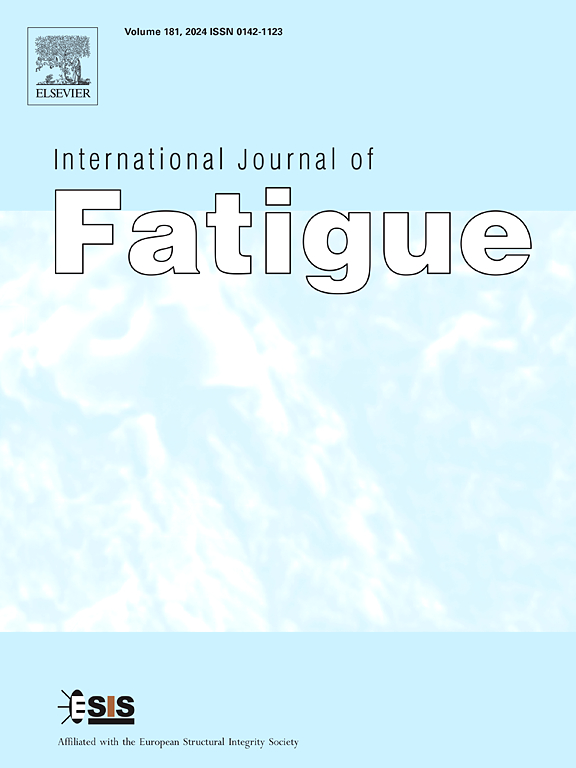Retarded fatigue crack growth in Fe–15Mn–10Cr–8Ni–4Si via reversible γ ↔ ε transformation
IF 5.7
2区 材料科学
Q1 ENGINEERING, MECHANICAL
引用次数: 0
Abstract
Crack growth and closure behavior in Fe–15Mn–10Cr–8Ni–4Si steel were investigated. The steel showed slower crack growth compared with SUS316. This was mainly due to the pronounced effect of crack closure. The gradual cyclic hardening in the Fe–15Mn–10Cr–8Ni–4Si steel have enhanced the effect of plasticity-induced crack closure compared with that in SUS316. Additionally, the rough fracture surface consisting of facets and crack branching of the Fe–15Mn–10Cr–8Ni–4Si steel have caused fracture surface roughness-induced crack closure. Transmission electron microscopy observations of the deformation microstructure beneath the fracture surface revealed that martensitic transformation occurred in both the Fe–15Mn–10Cr–8Ni–4Si steel and SUS316, with the latter exhibiting more pronounced transformation. Therefore, although transformation-induced crack closure was more enhanced in SUS316, it did not outweigh the effects of other crack closure mechanisms. The difference in crack growth rate between the Fe–15Mn–10Cr–8Ni–4Si steel and SUS316 remained even when the effect of crack closure was removed. The highly reversible nature of the dislocation motion manifesting as reversible γ ↔ ε transformation works as a crack retardation mechanism in Fe–15Mn–10Cr–8Ni–4Si steel.

通过可逆γ↔ε转变延缓Fe-15Mn-10Cr-8Ni-4Si的疲劳裂纹扩展
研究了Fe-15Mn-10Cr-8Ni-4Si钢的裂纹扩展和闭合行为。与SUS316相比,该钢的裂纹扩展速度较慢。这主要是由于裂缝闭合效果显著。与SUS316相比,Fe-15Mn-10Cr-8Ni-4Si钢的逐渐循环硬化增强了塑性裂纹闭合的效果。此外,Fe-15Mn-10Cr-8Ni-4Si钢的粗糙断口由切面和裂纹分支组成,导致断口表面粗糙度导致裂纹闭合。断口变形组织透射电镜观察表明,Fe-15Mn-10Cr-8Ni-4Si钢和SUS316均发生马氏体相变,SUS316相变更为明显。因此,虽然在SUS316中相变诱导的裂纹闭合更强,但它并没有超过其他裂纹闭合机制的影响。即使去除裂纹闭合的影响,Fe-15Mn-10Cr-8Ni-4Si钢与SUS316之间裂纹扩展速率的差异仍然存在。在Fe-15Mn-10Cr-8Ni-4Si钢中,位错运动的高度可逆表现为可逆γ↔ε转化,这是一种裂纹延迟机制。
本文章由计算机程序翻译,如有差异,请以英文原文为准。
求助全文
约1分钟内获得全文
求助全文
来源期刊

International Journal of Fatigue
工程技术-材料科学:综合
CiteScore
10.70
自引率
21.70%
发文量
619
审稿时长
58 days
期刊介绍:
Typical subjects discussed in International Journal of Fatigue address:
Novel fatigue testing and characterization methods (new kinds of fatigue tests, critical evaluation of existing methods, in situ measurement of fatigue degradation, non-contact field measurements)
Multiaxial fatigue and complex loading effects of materials and structures, exploring state-of-the-art concepts in degradation under cyclic loading
Fatigue in the very high cycle regime, including failure mode transitions from surface to subsurface, effects of surface treatment, processing, and loading conditions
Modeling (including degradation processes and related driving forces, multiscale/multi-resolution methods, computational hierarchical and concurrent methods for coupled component and material responses, novel methods for notch root analysis, fracture mechanics, damage mechanics, crack growth kinetics, life prediction and durability, and prediction of stochastic fatigue behavior reflecting microstructure and service conditions)
Models for early stages of fatigue crack formation and growth that explicitly consider microstructure and relevant materials science aspects
Understanding the influence or manufacturing and processing route on fatigue degradation, and embedding this understanding in more predictive schemes for mitigation and design against fatigue
Prognosis and damage state awareness (including sensors, monitoring, methodology, interactive control, accelerated methods, data interpretation)
Applications of technologies associated with fatigue and their implications for structural integrity and reliability. This includes issues related to design, operation and maintenance, i.e., life cycle engineering
Smart materials and structures that can sense and mitigate fatigue degradation
Fatigue of devices and structures at small scales, including effects of process route and surfaces/interfaces.
 求助内容:
求助内容: 应助结果提醒方式:
应助结果提醒方式:


